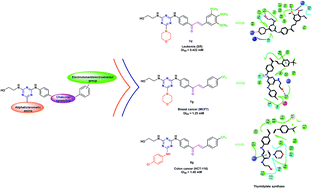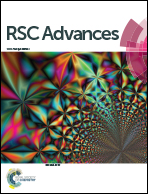Synthesis, biological evaluation, and in silico studies of novel chalcone- and pyrazoline-based 1,3,5-triazines as potential anticancer agents†
Abstract
A novel series of triazin-chalcones (7,8)a–g and triazin-N-(3,5-dichlorophenyl)pyrazolines (9,10)a–g were synthesized and evaluated for their anticancer activity against nine different cancer strains. Triazine ketones 5 and 6 were synthesized from the cyanuric chloride 1 by using stepwise nucleophilic substitution of the chlorine atom. These ketones were subsequently subjected to a Claisen–Schmidt condensation reaction with aromatic aldehydes affording chalcones (7,8)a–g. Then, N-(3,5-dichlorophenyl)pyrazolines (9,10)a–g were obtained by cyclocondensation reactions of the respective chalcones (7,8)a–g with 3,5-dichlorophenylhydrazine. Among all the evaluated compounds, chalcones 7d,g and 8g exhibited more potent in vitro anticancer activity, with outstanding GI50 values ranging from 0.422 to 14.9 μM and LC50 values ranging from 5.08 μM to >100 μM. In silico studies, for both ligand- and structure-based, were executed to explore the inhibitory nature of chalcones and triazine derivatives. The results suggested that the evaluated compounds could act as modulators of the human thymidylate synthase enzyme.



 Please wait while we load your content...
Please wait while we load your content...